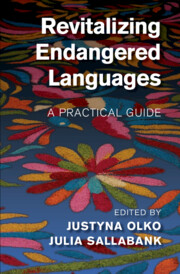Contents
6Types of Communities and Speakers in Language Revitalization
8Some Considerations about Empowerment and Attitudes in Language Revitalization
9Economic Benefits: Marketing and Commercializing Language Revitalization
10Local Power Relationships, Community Dynamics, and Stakeholders
12Making Links: Learning from the Experience of Others in Language Revitalisation
15Teaching Strategies for Language Revitalization and Maintenance
15.1Ka Hoʻōla ʻŌlelo Hawaiʻi I O Nā Kula: Hawaiian Language Revitalization through Schooling
15.2Kristang Language Revitalization in Singapore under the Kodrah Kristang Initiative, 2016–Present
15.5Culture Place-Based Language Basketry Curriculum at the Confederated Tribes of the Grand Ronde Community
15.6Sámi School Education and Cultural Environmentally Based Curriculum
15.8We Stand Strong in Our Knowledge: Learning Anishinaabemowin One Word Bundle at a Time



